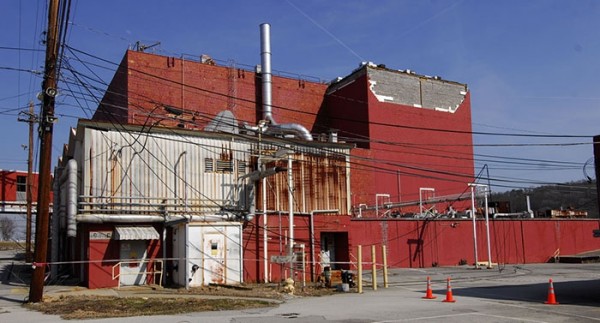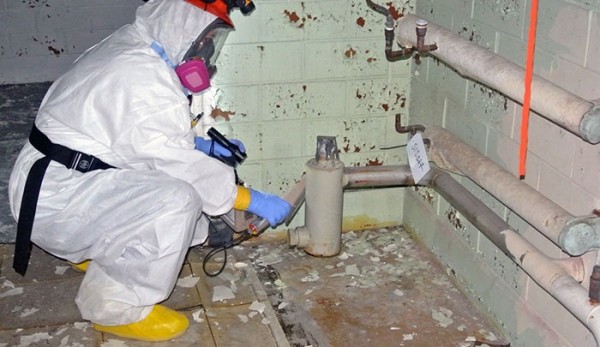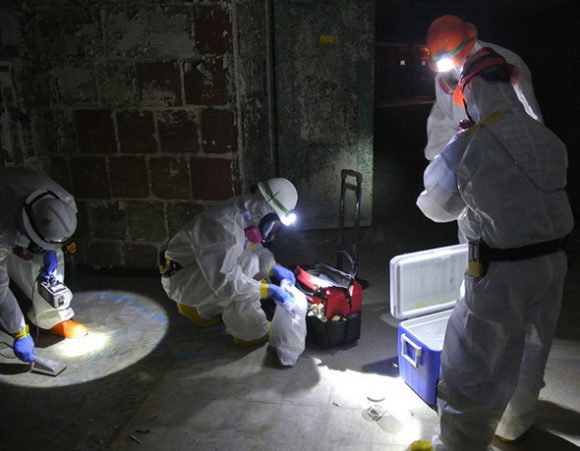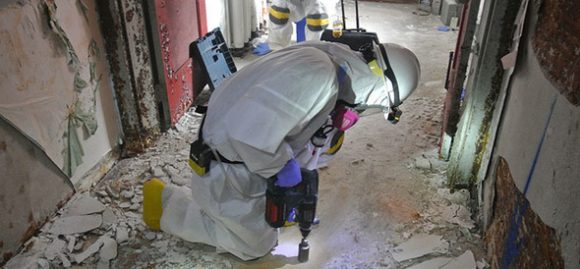
An aerial view of the Biology Complex at the Y-12 National Security Complex. Plans call for eventually demolishing the complex. (Photo courtesy U.S. Department of Energy)
Biology Complex at Y-12 once housed more individuals with doctorates than anywhere else in the world
The U.S. Department of Energy and its cleanup contractor finished characterizing the Biology Complex at the Y-12 National Security Complex this month, identifying contaminants before demolishing and disposing of the buildings.
The characterization work was done by DOE’s Oak Ridge Office of Environmental Management and its contractor, URS | CH2M, or UCOR.
DOE said it was crucial to get crews into the complex before the working environment became too hazardous.
“Already, team members could not enter a building due to a failed roof,” the Department of Energy said in a story published online on Thursday. “Elsewhere, exterior tiles have fallen from the façade, and asbestos and other material present risks to workers due to roof leaks.”
Jay Mullis, acting manager for the Oak Ridge Office of Environmental Management, said the completion of the characterization work sets up the cleanup program to demolish Y-12’s Biology Complex when funds become available.
“Our goal is to eventually take down this 1940s-era complex, which will eliminate safety risks and provide land for Y-12 to continue its important national security missions,” Mullis said.
The project is part of DOE’s Excess Contaminated Facilities Initiative, an effort to reduce risks and stabilize facilities not scheduled for near-term demolition.
In this case, the environmental management, or EM, activities could actually accelerate the demolition schedule for the Biology Complex because its facilities are collapsing due to age, and the location can be used for modern national defense missions, DOE said.
Eight remaining complex buildings, which span almost 350,000 square feet and are owned by DOE’s Office of Science at Y-12, a National Nuclear Security Administration site, have been vacant since the early 2000s. Like many facilities built in the 1940s, the characterization results showed significant amounts of asbestos and other wastes, such as polychlorinated biphenyls, or PCBs, DOE said. Workers also found radiological constituents in some buildings.
The characterization results verified that six of the buildings could be disposed in the Y-12 sanitary landfills because they do not contain radiological contamination. The remaining two will be disposed in the Environmental Management Waste Management Facility, an onsite Comprehensive Environmental Response, Compensation, and Liability Act, or CERCLA, disposal facility for the majority of cleanup-generated debris, DOE said.
Originally constructed to recover uranium from process streams, the complex later housed DOE’s research on the genetic effects of radiation from the late 1940s. The facilities once housed more individuals with doctorates than anywhere in the world, according to the Department of Energy.
The complex originally consisted of 12 buildings until EM demolished four of them in 2010 as part of the American Recovery and Reinvestment Act.

In an example of the disrepair, tiles had fallen from the façade of Building 9211 in the Biology Complex at Y-12 National Security Complex. Building 9211 was demolished with help from the Recovery Act. Plans call for eventually demolishing the remaining portion of the Biology Complex. (Photo courtesy U.S. Department of Energy)

A worker surveys a pipe for contamination inside the Biology Complex at Y-12 National Security Complex. (Photo by the U.S. Department of Energy)

Crew members prepare samples for shipment to the laboratory for analysis from inside the Biology Complex at Y-12 National Security Complex. (Photo courtesy U.S. Department of Energy)

A worker takes a sample from a concrete floor inside the Biology Complex at Y-12 National Security Complex. (Photo by the U.S. Department of Energy)
More information will be added as it becomes available.
Note: This is an edited version of a story—”EM Completes Characterization of Y-12’s Biology Complex”—published Thursday by DOE’s Office of Environmental Management.
Do you appreciate this story or our work in general? If so, please consider a monthly subscription to Oak Ridge Today. See our Subscribe page here. Thank you for reading Oak Ridge Today.
Copyright 2017 Oak Ridge Today. All rights reserved. This material may not be published, broadcast, rewritten, or redistributed.
Leave a Reply